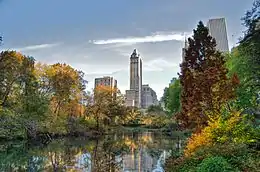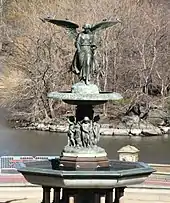Ballplayers House
Ballplayers House is a small building in Central Park in Manhattan, New York City, designed by the architecture firm Buttrick White & Burtis. Completed in 1990, it replaced an older building, architect Calvert Vaux's Boys Play House of 1868, which stood on the northern edge of the Heckscher Ballfields until it was demolished in 1969. Vaux's building was a fifty-two foot long clubhouse and dispensary for bats and balls,[1] whereas Buttrick White & Burtis' building is a food concession half the size of the original.

Design
The Ballplayers House recalls Vaux's design, albeit much altered in form and detail. In contrast to the brick and bluestone facade of Vaux's building, with its pointed arches and polychrome voussoirs, the facade of Ballplayers House is composed with graphic stripes of highly contrasting brick. In lieu of Vaux's bracketed eaves, pointed pinnacles and chamfered chimney, the new building boasts a simple roofline, topped with a sleek, factory-made cresting.

The Ballplayers House is decorated with a tile frieze with a simple flower motif symbolizing a ball-field, and a zig-zag pattern symbolizing a bouncing ball. Elizabeth Barlow Rogers, head of the Central Park Conservancy when the Ballplayers House was built, described its design as "a contemporary interpretation of Vaux's style."[2]
Gallery
 Boys Play House, built in 1868
Boys Play House, built in 1868.jpg.webp) 1868 Map of Central Park, showing the Boys Play House just south (left) of "Road No. 1"
1868 Map of Central Park, showing the Boys Play House just south (left) of "Road No. 1" Ball Field and Boys Play House, 1869
Ball Field and Boys Play House, 1869 An 1870 Stereoscope view of the Boys Playground with architect Calvert Vaux's Boys Play House in the distance.
An 1870 Stereoscope view of the Boys Playground with architect Calvert Vaux's Boys Play House in the distance. A View of the Boys Play House
A View of the Boys Play House
References
- Eleventh Annual Report of the Board of Commissioners of the Central Park, 1868, page 26.
- Elizabeth Barlow Rogers, "Robert Moses and the Transformation of Central Park." Site/Lines, A Journal of Place (Fall 2007), Volume III, No. 1.


.jpg.webp)
